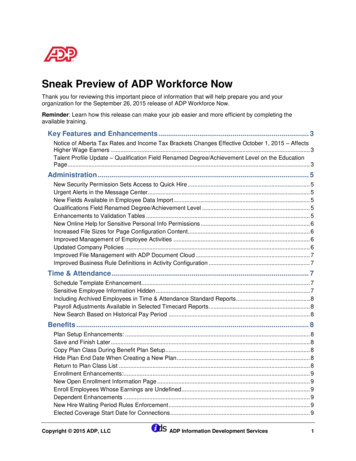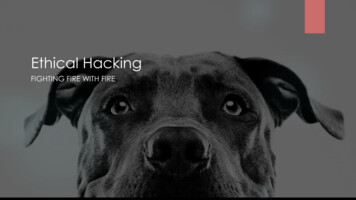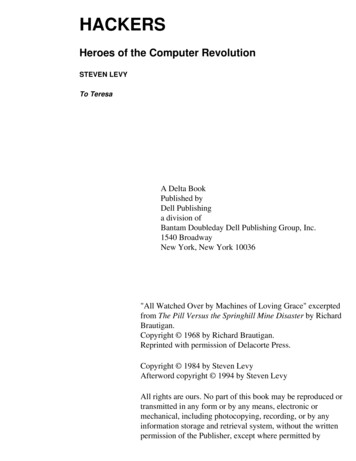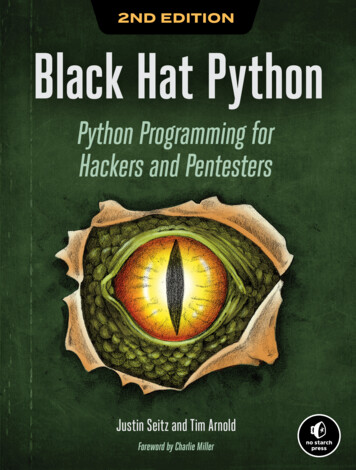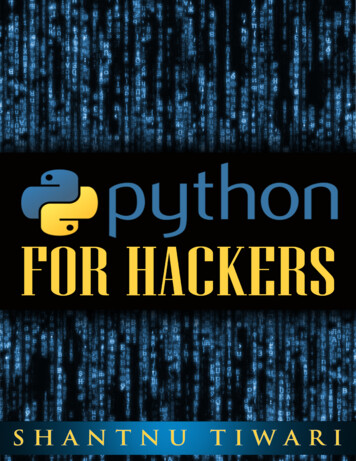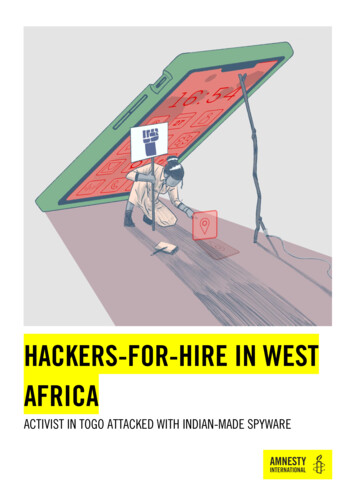
Transcription
HACKERS-FOR-HIRE IN WESTAFRICAACTIVIST IN TOGO ATTACKED WITH INDIAN-MADE SPYWARE
Amnesty International is a movement of 10 million people whichmobilizes the humanity in everyone and campaigns for changeso we can all enjoy our human rights.Our vision is of a world where those in power keep theirpromises, respect international law and are held to account.We are independent of any government, political ideology,economic interest or religion and are funded mainly by ourmembership and individual donations. We believe that acting insolidarity and compassion with people everywhere can changeour societies for the better. Amnesty International 2021Except where otherwise noted, content in this document is licensed under a Creative Commons(attribution, non-commercial, no derivatives, international 4.0) -nd/4.0/legalcodeFor more information please visit the permissions page on our website: www.amnesty.orgWhere material is attributed to a copyright owner other than Amnesty International thismaterial is not subject to the Creative Commons licence.First published in 2021by Amnesty International LtdPeter Benenson House, 1 Easton StreetLondon WC1X 0DW, UKIndex: AFR 57/4756/2021Original language: Englishamnesty.orgCover photo: A drawing of an activist looking at a GPS location icon on the ground. A large mobilephone overshadows the activist illustrating how individuals can be tracked by their mobile devices. derooted
CONTENTS1.EXECUTIVE SUMMARY52.METHODOLOGY73.BACKGROUND83.1 TARGETED SURVEILLANCE: A THREAT FOR HRDS4.TECHNICAL INVESTIGATION9114.1 FIRST ATTACKS114.2 INVESTIGATING THE ATTACK INFRASTRUCTURE144.3 CONNECTIONS WITH DONOT TEAM184.4 A FORTUITOUS DISCOVERY184.5 LINKS BETWEEN INNEFU LABS IP ADDRESS AND ANDROID ATTACK INFRASTRUCTURE204.6 LINKS BETWEEN INNEFU LABS AND THE SPYWARE ATTACK IN TOGO224.7 WHO IS INNEFU LABS?235.25HUMAN RIGHTS CONCERNS5.1 HUMAN RIGHTS CONCERNS AND INNEFU LABS’ RESPONSIBILITIES255.2 CYBER MERCENARIES ON THE RISE265.3 CIVIL SOCIETY UNDER SURVEILLANCE IN TOGO275.4 SHRINKING SPACE FOR HUMAN RIGHTS WORK IN TOGO276.30CONCLUSION AND RECOMMENDATIONS6.1 RECOMMENDATIONS30ANNEX 1: COMMUNICATIONS WITH INNEFU LABS33RESPONSE TO RESEARCH LETTER RECEIVED FROM INNEFU LABS ON 30 OCTOBER 202033RESPONSE FROM INNEFU LABS TO AMNESTY INTERNATIONAL ON 30 OCTOBER 202134RESPONSE FROM INNEFU LABS TO AMNESTY INTERNATIONAL ON 5 OCTOBER 202134ANNEX 2: TECHNICAL APPENDIX36TECHNICAL ANALYSIS OF MALICIOUS DOCUMENTS AND SOFTWARE36HACKERS-FOR-HIRE IN WEST AFRICAACTIVIST IN TOGO UNDER ATTACK WITH INDIAN-MADE SPYWAREAmnesty International3
GLOSSARYWORDDESCRIPTIONCOMMAND &CONTROLA Command & Control (C&C) server is the network infrastructure that is beingused by an attacker to collect stolen information. Spyware would normally beconfigured to communicate with a particular Command & Control server,identifiable either by a domain name or by an IP address.HACKER-FORHIREA cyberthreat actor (“a hacker”) which performs offensive cyber operations onbehalf of its customers. These customers may include multiple governmentagencies, foreign governments or commercial entities.INTERNET SCANAn internet scan is a type of network measurement which involves making aconnection to all or a subset of systems available on the internet. This can beused to identify systems running a particular piece of software, such as a customcommand & control server software.IP ADDRESSAn IP address is an unique string of characters used to identify a computer whichis communicating over the Internet or a local network. IP addresses are used toidentify the source and recipient of an IP packet on the network.MALWAREMalicious software that is designed to be silently installed on a victim’s computeror phone with the intent to steal private information or perform other forms offraud.PHISHINGA form of cyberattack in which fake login pages of legitimate services (such asGmail or Facebook) are created and distributed in order to collect victims’usernames and passwords.SPYWARE ORTROJANMalware that is designed to stealthily spy on the victim’s computer or phone andcontinuously monitor communications and steal private information and files.SQLStructured Query Language (SQL) is a computer language designed for storingand modifying records in a relation database. Relation databases can be exportedin a textual format which adheres to the SQL standard.THREAT ACTORA threat actor is a term used to in the cyber community to refer to the individualor group responsible for a set of attack campaigns.HACKERS-FOR-HIRE IN WEST AFRICAACTIVIST IN TOGO UNDER ATTACK WITH INDIAN-MADE SPYWAREAmnesty International4
1. EXECUTIVE SUMMARY“Having realized that this was an attempt at digitalespionage, I felt in danger. I can't believe that my work couldbe so disturbing to some people that they would try to spy onme. I am not the only one working for human rights in Togo.Why me?”Togo-based human rights defender who was targeted by this surveillance campaign.Amnesty International has uncovered a targeted digital attack campaign against a prominent human rightsdefender (HRD) in Togo. The HRD was targeted in late 2019 and early 2020 with both Android andWindows spyware. The attackers did not successfully compromise the HRD’s devices.The Amnesty International Security Lab investigation found that the spyware used in these attack attempts istied to an attacker group known in the cybersecurity industry as the Donot Team, previously connected toattacks in India, Pakistan and neighbouring countries in South Asia. Digital records identified during thisinvestigation reveal that hundreds of individuals across South Asia and the Middle East were also targeted byDonot Team Android spyware. However, further investigation into these targets is outside the remit of thisreport as it focuses on the digital attacks against the Togolese HRD.Amnesty International has also identified apparent links between the Donot Team spyware and an Indiancybersecurity company, Innefu Labs Pvt. Ltd., which advertises digital security, data analytics, and predictivepolicing services to law enforcement and armed forces. Amnesty International found two key pieces ofevidence connecting Innefu Labs to the Donot Team Android spyware and to the specific infrastructure usedto deliver the Android spyware to the HRD in Togo.Firstly, Amnesty International found a screenshot from an infected test Android phone exposed on a DonotTeam server. The screenshot shows an operator apparently testing the Donot Team Android spyware. Theoperator is communicating with a WhatsApp account called “UserTester” and sending messages such as“Testing WhatsApp notifications”. This suggests the attacker is testing the functionality of the spyware.The screenshot was taken as the attacker was in the process of typing using the custom SwiftKey keyboardon the device. The SwiftKey keyboard suggested two URLs which had previously been typed and stored onthe custom keyboard. One of these URLs was the spyware distribution website, bulk[.]fun, used to sendspyware to the HRD in Togo. The other was an IP address tied to Innefu Labs.The Innefu Labs IP address and the bulk[.]fun URL would only be suggested by the keyboard if the attackerusing this test phone had previously interacted with both the spyware server and the Innefu Labs IP address.Secondly, the same Innefu Labs IP address was recorded in log files left publicly exposed on the bulk[.]funwebsite used to distribute Donot Team spyware. This links the Innefu Labs IP address not only to the testingof the Donot Team Android spyware, but to the specific Internet infrastructure involved in the distribution ofthe spyware used to target the HRD in Togo.HACKERS-FOR-HIRE IN WEST AFRICAACTIVIST IN TOGO UNDER ATTACK WITH INDIAN-MADE SPYWAREAmnesty International5
Additional circumstantial evidence corroborating spyware development activity linked to Innefu Labs ispresented later in this report.The technical evidence suggests that Innefu Labs is involved in the development or deployment of someDonot Team spyware tools. These tools may then be used by a range of hacker-for-hire actors which aregrouped under the “Donot Team” cluster.There is no sufficient evidence to indicate whether Innefu Labs had any direct involvement in the targeting ofthe HRD in Togo. Although the Innefu Labs IP address is connected to both the spyware distribution websiteand to the Donot Team spyware, Innefu Labs may not necessarily know how any third parties are using thesespyware tools.The activity linked to the Donot Team may involve multiple distinct actors or organisations with access to thesame custom spyware toolset. The identity of all individuals or groups involved with Donot Team activity isunknown. This report focuses only on the actors linked to the attempted attacks against the HRD in Togo.These attacks may involve only a subset of the Donot Team attack group or be linked to a separate groupwith access to the Donot Team spyware tools.Based on the evidence collected in this research Amnesty International believes that Innefu Labs may play arole in the development and/or deployment of some of the spyware tools which have been previously linkedto Donot Team.This case highlights the threat “hacker-for-hire”-type attacks pose to human rights defenders and to civilsociety globally. “Hacker-for-hire” attacks are offensive cyber operations performed by a threat actor (“ahacker”) normally on behalf of paying customers. These customers may include domestic governmentagencies, foreign governments or commercial entities. Cyber operations can be used for intelligencegathering, destructive attacks (such as damaging industrial systems) or financial gain.Innefu Labs should urgently conduct an external audit and publish the findings of the audit regarding theapparent links between Innefu Labs and the spyware infrastructure used in the attacks against the HRDfrom Togo. Innefu Labs should further urgently adopt a human rights policy and conduct adequate humanrights due diligence, the results of which should be disclosed, to identify, prevent, mitigate, and address anyadverse human rights impacts which Innefu Labs may cause, contribute to, or be directly linked to.States have a responsibility to respect and protect human rights. The Indian government should launch acredible, transparent, independent, and impartial investigation into the cyberattacks which are linked to theDonot Team group and to Innefu Labs. Further, authorities in both India and Togo should impose animmediate moratorium on the sale, transfer, and use of spyware technology until there is a robust humanrights-compliant regulatory framework in place.The Togo government should take steps to investigate, and redress the harm caused by such attacks fromprivate actors or entities.HACKERS-FOR-HIRE IN WEST AFRICAACTIVIST IN TOGO UNDER ATTACK WITH INDIAN-MADE SPYWAREAmnesty International6
2. METHODOLOGYThis report investigates attempted targeted digital surveillance against a prominent HRD based in Togo. Itcovers specific attack attempts that occurred between December 2019 and January 2020. The primaryinvestigation occurred in early 2020 with additional technical research carried out in the spring of 2021.In December 2019, Amnesty International’s Security Lab was contacted by the HRD after they beganreceiving suspicious messages on their mobile phone and later by email. The HRD is not named in thisreport for security reasons.Amnesty International investigated the attempted attacks using a multidisciplinary research method.Primarily the attacks and related spyware samples were analysed using technical malware analysis andreverse engineering techniques. Suspicious samples were run in malware sandboxes and manually analysedto confirm malicious behaviour. Malware sandboxes are isolated computer environments where spyware canbe safely run, and its behaviour monitored and recorded.Starting with the initial spyware samples, Amnesty International’s Security Lab utilized an internet-widenetwork scanning methodology to identify additional servers, infrastructure and other digital resources whichwere owned or controlled by the threat actor linked to these digital attacks.This report also draws on threat intelligence reports published by companies in the cybersecurity industrywhich describe spyware attacks used by this and related threat actors over the past 10 years. While thesereports provided context on the threat actor, they were not used as part of the attribution of these attacks. Alldata used for attribution of these attacks was obtained directly by Amnesty International from open sourcesand publicly exposed locations on attacker-linked infrastructure.Amnesty International also used standard “open-source intelligence” techniques to identify relevant publiclyavailable information from websites and social media. This information was used to corroborate informationinitially discovered using the described technical research methodology.Additionally, Amnesty International collected testimony from the HRD who was targeted by these attacks.Relevant human rights literature was reviewed when preparing this report.HACKERS-FOR-HIRE IN WEST AFRICAACTIVIST IN TOGO UNDER ATTACK WITH INDIAN-MADE SPYWAREAmnesty International7
3. BACKGROUNDIn December 2019, Togolese President Faure Gnassingbé was seeking to run for a fourth term in the thenupcoming February 2020 elections. In May 2019, the parliament had approved a constitutional changepermitting the incumbent president to potentially stay in office until 2030. The opposition had boycottedlegislative elections in December 2018, in part because of the dispute over term limits.The presidential election took place in February 2020. Faure Gnassingbé was elected for a fourth termfollowing the election with 72% of the votes. The re-election was contested by the opposition.In the backdrop of a tense political climate and in anticipation of the elections, Togo experienced acrackdown against peaceful dissent. During this time a prominent Togolese HRD, who wishes to remainanonymous for security reasons, reached out to Amnesty International’s Security Lab alarmed by suspiciousWhatsApp messages they were receiving on their mobile phone.These messages were sent from a WhatsApp account registered to an Indian phone number. The accountrepeatedly wrote in English, encouraging the HRD to install an Android chat application in order to continuetheir communications.This was not a normal Android application. Instead, it was piece of custom Android spyware designed toextract some of the most sensitive and personal information stored on the HRD’s phone. If successfullyinstalled on the device, it would allow the attackers to record the camera and microphone, collect photosand files stored on the device, and even read encrypted WhatsApp messages as they were being sent andreceived. Amnesty International’s Security Lab investigated these attacks and identified the threat actorcommonly known as Donot Team within the cybersecurity industry as responsible. Details of thisinvestigation are set out in the following chapter.Previously reported attack campaigns were tied to Donot Team based on the use of a common set of customspyware tools and infrastructure. The Donot Team attacks may involve multiple distinct actors ororganisations with access to the same custom spyware toolset. The identity of all individuals or groupsinvolved with Donot Team activity is unknown.Previously, this group has only been publicly linked to digital attacks on political and military targets in SouthAsia.1A threat actor is a term used in the cybersecurity community to refer to the individual or group responsible for a set ofattack campaigns. Cybersecurity researchers create nicknames, in this case Donot Team, to refer to an actor. Theidentity or the affiliation of the actor may or may not be known. These attack campaigns can be linked based on the useof the same non-public spyware tools, the use of related infrastructure between campaigns, or based on commontargeting.Positive Technologies, “Studying Donot Team”, 25 November 1HACKERS-FOR-HIRE IN WEST AFRICAACTIVIST IN TOGO UNDER ATTACK WITH INDIAN-MADE SPYWAREAmnesty International8
3.1 TARGETED SURVEILLANCE: A THREAT FOR HRDSThe targeting of HRDs using digital surveillance technology is unlawful under international human rights law.Amnesty International believes that the Togolese HRD was targeted solely on the basis of their human rightswork. The prominent HRD has a long history of working with Togolese civil society organisations and is anessential voice for human rights in the country. There is no suggestion that this HRD has been targeted forany legitimate purpose or charged with any crime. This unlawful surveillance violates their right to privacyand impinges on their rights to freedom of expression and opinion, of association and of peaceful assembly.Both the Universal Declaration of Human Rights and the International Covenant on Civil and Political Rightsprotect these rights. The Covenant guarantees the right to hold opinions without interference and the right tofree expression (Article 19) and guards against arbitrary and unlawful intrusion of privacy (Article 17).International law and standards also require that any interference by the state on the right to privacy shouldbe lawful, necessary, proportional, and legitimate. States are required to ensure that individuals whose rightshave been violated have access to remedy (Article 2(3)). This includes the positive obligation to takeappropriate measures to prevent, punish, investigate or redress the harm caused by such acts by privatepersons or entities, including from harm caused by surveillance companies.Under the UN Guiding Principles on Business and Human Rights, all companies themselves have anindependent responsibility to respect human rights.2 This responsibility “ is a global standard of expectedconduct for all business enterprises wherever they operate and it exists over and above compliance withnational laws and regulations protecting human rights.”3Increasingly, HRDs worldwide have to reckon with the growing threat of unlawful targeted surveillance,alongside more traditional methods of repression. Companies who produce and market cybersurveillancetools or who directly provide ‘hacker-for-hire' services on behalf of others have become dangerous actorsresponsible for creating new tools for repression and exacerbating threats against those who defend ourhuman rights.The Pegasus Project, coordinated by Forbidden Stories with the technical support of Amnesty International’sSecurity Lab revealed how governments around the world have abused sophisticated cybersurveillance toolsto unlawfully surveil journalists, HRDs and political opposition.4 These revelations provide a snapshot of theabuses linked to just a single company operating in the offensive cybersurveillance industry.Even less is known about the “hacker-for-hire” industry. Due to weak regulatory and legal oversight,companies can freely sell their technology and services to private clients or countries where human rightsare not protected or respected, and then in turn use the technology to track and monitor those who defendhuman rights. Multiple “hacker-for-hire” companies have advertised legitimate cybersecurity services whilecovertly carrying out offensive digital attacks for their clients.5It is often virtually impossible for HRDs to prove the existence of surveillance, either because of technicalhurdles or because its use is covert. Even where targeting or the presence of an active infection cannot beproven, the fact of living under the constant threat of possible surveillance may constitute a human rightsviolation in itself. Regardless of whether the attempt at surveillance is successful or not, the targeting ofhuman rights activists instils fear and has a chilling effect on their ability to continue their work withoutundue interference. In many instances this leads those who defend human rights to self-censor and refrainfrom exercising their rights to freedom of expression, association and peaceful assembly. Inadequateregulation and oversight by the state – in violation of international standards – is the cause of this chillingeffect, and therefore the responsibility of the state to remedy, in line with its obligations to respect, protectand fulfil human rights.The threat of surveillance may also have a detrimental effect on the mental health of HRDs and informationmay be used to divulge details in the public sphere exposing them and/or their contacts to personal attacksOffice of the UN High Commissioner for Human Rights (OHCHR), Guiding Principles on Business and Human Rights: Implementing theUnited Nations “Protect, Respect and Remedy” Framework, 2011 (UN Guiding Principles).3UN Guiding Principles, commentary to Principle 11.4Amnesty International, “Massive data leak reveals Israeli NSO Group’s spyware used to target activists, journalists, and political leadersglobally”, 18 July 2021, gasus-project.5John Scott-Railton and others, “Dark Basin: Uncovering a Massive Hack-For-Hire Operation”, Citizen Lab, 9 June -massive-hack-for-hire-operation.2HACKERS-FOR-HIRE IN WEST AFRICAACTIVIST IN TOGO UNDER ATTACK WITH INDIAN-MADE SPYWAREAmnesty International9
and smear campaigns. All of this has a damaging knock-on effect on communities and societies whoserights HRDs are fighting for.Indeed, the Togolese HRD who was targeted told Amnesty International: “I felt in danger. I can't believe thatmy work could be so disturbing to some people that they would try to spy on me. I am not the only oneworking for human rights in Togo. Why me?"HACKERS-FOR-HIRE IN WEST AFRICAACTIVIST IN TOGO UNDER ATTACK WITH INDIAN-MADE SPYWAREAmnesty International10
4. TECHNICALINVESTIGATION4.1 FIRST ATTACKSOn the 26 December 2019, the HRD in Togo received unexpected messages in English on their mobilephone on WhatsApp. The unknown contact pretended to know the HRD and tried to convince them to installa chat application, seemingly called ChatLite:HACKERS-FOR-HIRE IN WEST AFRICAACTIVIST IN TOGO UNDER ATTACK WITH INDIAN-MADE SPYWAREAmnesty International11
Amnesty International analysed this application and confirmed that it was malicious and related to a knownAndroid spyware family called “StealJob”.6 Later the attackers sent the HRD two additional download linksfor the app. At this point, the HRD was already aware that these messages were not legitimate. Thesubsequent messages asking for new links were an attempt to collect additional information which washelpful in tracing these attacks:Both links pointed to the website https://bulk.fun/ and ended with two random characters. This websiteappeared to be a URL shortening service operated by the attackers. Each of the links redirected targets tomalicious Android applications. More information on URL shortening services and how they were used inthis attack is included in the next section of the report. The HRD did not click on the links but insteadforwarded screenshots of the suspicious messages to the Amnesty International Security Lab.QI-ANXIN, “StealJob: New Android malware used by Donot APT group”, 10 April 2019, alware-used-by-donot-apt-group.6HACKERS-FOR-HIRE IN WEST AFRICAACTIVIST IN TOGO UNDER ATTACK WITH INDIAN-MADE SPYWAREAmnesty International12
The Android application masqueraded as a chat application named ChatLite but it was actually a customdeveloped Android spyware tool that, when successfully deployed, allows the attackers to collect sensitivedata from victims’ mobile devices and install additional spyware tools.THE ATTACKERS CHANGE APPROACHThe first attempted attack on the HRD, who is French speaking, failed. The attacker’s strangely wordedmessages, written in English and coming from an unknown Indian phone number alarmed the HRD whothen became immediately suspicious. Attempts to use French words such as “bonjour” alongside brokenEnglish did not add to the attacker’s credibility.Less than a month later, the HRD was approached again, this time over email. The attackers took more carewith this second attempt. The email was written in French and was sent from a Gmail accountjimajemi096[@]gmail.com with the Togolese name “atwoki logo”.HACKERS-FOR-HIRE IN WEST AFRICAACTIVIST IN TOGO UNDER ATTACK WITH INDIAN-MADE SPYWAREAmnesty International13
Subject: important detailshello ,all the details of the file .that is to be discussed.first save the file then you will see the contents (important)see attached fileThe email contained an attached malicious document which tries to exploit a previously fixed security flaw inMicrosoft Office.7 Windows spyware would be installed if the document was opened in an older vulnerableversion of Microsoft Word.This first stage spyware would eventually load Donot Team’s full Window spying tool known as the YTYframework. With the YTY framework installed, the attackers would gain complete access to the HRD’scomputer.The spyware can be used to steal files from the infected computer and any connected USB drives, recordkeystrokes, take regular screenshots of the computer, and download additional spyware components.This attack attempt was blocked by the HRD’s email security system. The email and attached maliciousdocument triggered an automated security alert which resulted in the email being quarantined.The YTY spyware is described in more detail in the Technical Appendix.4.2 INVESTIGATING THE ATTACK INFRASTRUCTUREAmnesty International began this investigation by mapping the infrastructure used by the attackers to deliverthe Android spyware. A search for the bulk.fun domain on the VirusTotal malware database returnedadditional samples of the same Android spyware. One named Kashmir Voice v4.8.apk and another namedSafeShareV67.apk. Both samples were identified by multiple antivirus vendors as being related to DonotTeam.8Since 2018, security researchers have documented Donot Team attacks targeting organisations andindividuals in South Asia, primarily in Pakistan and India.9 The targeting of this Togolese HRD is thereforeoutside the known geographic region of Donot Team’s previous activity.The initial spyware link received in the WhatsApp messages was generated by an attacker-run URLshortener. A URL shortener generates short URLs which redirect to another web page. URL shorteners areused by attackers for two reasons: to hide the ultimate destination of a link; and to collect information aboutthe target when the link is opened, including their IP address, location, and the model of the target device.The malicious document loaded a remote template which attempted to exploit CVE-2017-0199, a vulnerability in handling RTF documentswith embedded OLE2 objects.8VirusTotal, Netscout, “Donot Team Leverages New Modular Malware Framework in South Asia”, 8 March FOR-HIRE IN WEST AFRICAACTIVIST IN TOGO UNDER ATTACK WITH INDIAN-MADE SPYWAREAmnesty International14
The URL shortener used by these attackers generated particularly short URLs containing just one or twocharacters. Amnesty International researchers were able to calculate and analyse all possible URLspreviously generated by the attackers, a technique we call “Short URL enumeration”.Amnesty International found that hundreds of the Donot Team short links that were collected pointed toAndroid applications hosted on the attackers’ servers using malicious domains such as ppadoaolnwod[.]xyzand officeframework[.]online. The large number of links suggest the attackers were distributing their Androidspyware at a significant scale. The attackers may have generated unique links for targets to better trackwhich target clicked on a spyware link. In addition, some links pointed to Donot Team related Windowsspyware infrastructure and to credential phishing websites.One shortened link pointed to a cybersecurity report about an attack linked to Donot Team which also usedtheir YTY spyware. This suggests that the group is monitoring reports written about their own attackcampaigns.LOOKING BEHIND THE CURTAINAmnesty International researchers also discovered many Nextcloud links shared through the URL shortener.Nextcloud is an open-source software product that allows individuals or organisations to run their own filestorage and collaboration platform.It is important to note that this Nextcloud server was hosted on the same server as the bulk.fun URLshortener on the IP address 82.196.5.24. The usage of the same server to host the original AndroidHACKERS-FOR-HIRE IN WEST AFRICAACTIVIST IN TOGO UNDER ATTACK WITH INDIAN-MADE SPYWAREAmnesty International15
spyware, the bulk.fun URL shortener, and now the Nextcloud, show that all three are strongly interlinkedand controlled by the same attackers.Amnesty International researchers again downloaded all publicly accessible URLs hosted on the Nextcloudserver which were exposed by the URL shortener.The attackers had used their own Nextcloud server to share documents, back up files and spyware samplesbetween their team members. The attackers accidentally made this publicly available using their short links.This particularly careless exposure of operational documents enabled Amnesty International to gainunprecedented insights into the activities of Donot Team. It was through this method that AmnestyInternational found a Zip file named Downloads.zip, shared by the attackers which contained two SQLdatabase files. SQL file
4.5 links between innefu labs ip address and android attack infrastructure 20 4.6 links between innefu labs and the spyware attack in togo 22 4.7 who is innefu labs? 23 5. human rights concerns 25 5.1 human rights concerns and innefu labs' responsibilities 25 5.2 cyber mercenaries on the rise 26 5.3 civil society under surveillance in togo 27
